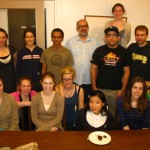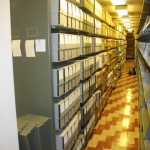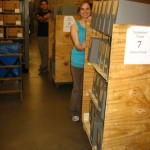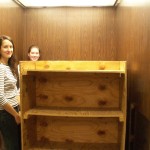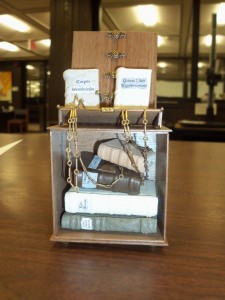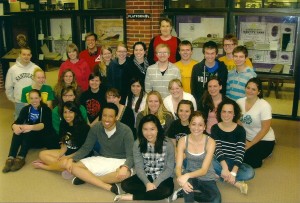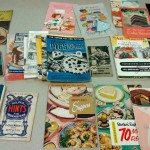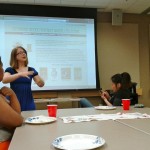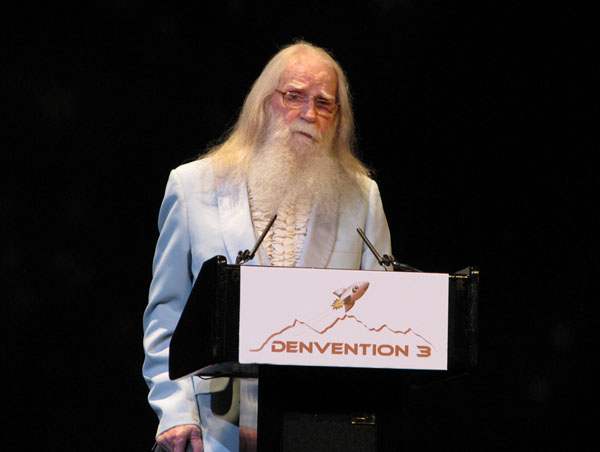There is one remaining aspect to highlight in our story of the move from the basement. That is delivering a big THANK YOU for the help we received from Carney-McNicholas Movers who took care of the last remaining extra-heavy lifting that completed the move! 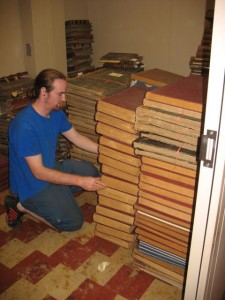
The Move Comes to an End
The busy noise of the crowds of students studying for finals has subsided but Special Collections & University Archives is peaceful not because the end of the semester has arrived but because the thunderous parade of carts has ceased. Our dedicated and cheerful crew of student workers finished the monumental task of moving the collections from the basement into newly vacated space on the third floor adjacent to the reading room. Not only are the collections now high and dry but the move united our collections on one floor making it easier and faster to retrieve items.
The students’ impressive work included replacing and dusting 3500 shelves (over 7000 total) and moving over 21,000 linear feet of material. That means that they moved the equivalent of 70 football fields or 4+ miles! Though some of the boxes weighed 40 pounds or more the weight and size of the task did not get them down as the process was filled with jokes and fun conversations.
Our gratitude goes out to everyone involved over the years from the hundreds of volunteers from across campus and the community who helped move materials before the 2008 flood and to our student workers and staff that helped with this move so that those efforts will never be necessary again. Each day as the collections continue to be used and bring joy to researchers, students, and all of us, we can all remember and be thankful for the many hands that came together who made it possible for that opportunity to continue.
New Acquisition
Harry Potter and the Quest for Enlightenment
Dragons, mandrakes, and potions have taken over the cases outside Special Collections & University Archives!
Students in Donna Parsons’ Honors Seminar titled “Harry Potter and the Quest for Enlightenment” have curated an exhibit using materials from Special Collections. The exhibit is one part of a semester long project utilizing Special Collections materials for research. The students chose one item to represent their research and worked together to fit their items into themes for display.
Parsons’ seminar has the students closely read the texts and analyze their themes as well as investigate the influences from the literary cannon and the effects on popular culture in the US and Britain. She envisioned the collaboration with Special Collections as an exciting opportunity to enhance student learning. “The Harry Potter series is filled with extensive references to science, literature, mythology, and history,” Parsons says. “Partnering with Special Collections has supplied my students with the resources needed to trace a specific reference and discuss its relevance to a particular scene, character, or plotline. The partnership has also provided the context for a deeper understanding of the series and its appeal to a diverse audience.”
Greg Prickman, Head of Special Collections & University Archives, welcomed the collaboration. “The idea to have the students create an exhibition was Donna’s, and we quickly agreed to it. Rather than showing or telling, we are giving them the chance to do their own showing and telling, which results in a unique learning opportunity that can only be experienced with access to original historical documents.”
Kelsey Sheets, a student in the seminar, loved finding out how complex the world of Harry Potter really is. “In the past I have read books about how J.K. Rowling draws inspiration from a wide variety of historical and mythical sources and incorporates them into the series, but my own research [on links between the study of Potions and the muggle study of Chemistry] really solidified this point and made me appreciate the depth of the wizarding world.”
The exhibit will be on display until June 12th on the third floor of the Main Library outside Special Collections & University Archives anytime the library is open.
Cooking Pamphlets as Culture
On April 14th Special Collections & University Archives staff visited the International Students’ Cooking Club. György Tóth, a PhD candidate in American Studies and the senior Olson Fellow, prepared some dishes from his native Hungary. Besides the dinner, the evening also featured an introduction to the Chef Louis Szathmáry II Collection of Culinary Arts, with an assortment of pamphlets on hand to browse and a discussion on culture as seen through cooking ephemera led by Outreach and Instruction Librarian Colleen Theisen. Since many of the international students in attendance were from China, the biggest hit of the evening was “The Art and Secrets of Chinese Cooking,” a pamphlet from the Beatrice Foods Company (including the La Choy line of products) from 1949.
Louis Szathmáry was a Hungarian émigré chef, teacher, writer, philanthrophist, an avid book collector, and is considered by many to be the first “celebrity-chef”. The Szathmáry Collection is made up of his extensive collection of books, pamphlets, and manuscripts relating to cooking. You can see digitized versions of many of the pamphlets from the Szathmáry collection here: http://digital.lib.uiowa.edu/szathmary/ and the finding aid to the entire collection is here: http://www.lib.uiowa.edu/spec-coll/MSC/ToMsc550/MsC533/MsC533.htm
Hevelin Collection
This week the University of Iowa Libraries is pleased to announce the acquisition of the James L. “Rusty” Hevelin Collection of Pulps, Fanzines, and Science Fiction Books. The original press release can be viewed here.
Rusty Hevelin passed away on December 27, 2011 after an illness. He was a science fiction fan, pulp collector, huckster (a dealer at conventions), and voracious reader for most of his 89 years. He hitchhiked to his first science fiction convention in Denver in 1941. The convention was called Denvention, and it was the third World Science Fiction Convention (the cons known as World Cons). He was the Fan Guest of Honor at Denvention 2 in 1981, and was a presenter at the Hugo Awards ceremony at Denvention 3 in 2008 (photo below from Keith Stokes).
To get a sense of what Rusty’s collection is like, it is helpful to get a sense of what Rusty himself was like. Those who knew Rusty were always impressed by his remarkable memory, and his many years as a science fiction fan made him the stereotypical “walking encyclopedia” of fandom. His early years as a fan, convention attendee, and fanzine writer and publisher were spent in the company, and often personal friendship, of great science fiction writers like Robert Heinlein, Ray Bradbury, Isaac Asimov, Frederik Pohl, Lester Del Rey, and many others. He witnessed the evolution of fandom, the adoption of science fiction by mainstream entertainment companies, and many other changes over the course of his lifetime.
There are several sources online for more details on Rusty’s life:
Interview in Transformative Works: link
Obituary at File 770: link
Gay Haldeman’s bio of Rusty for the Demicon 20 program book: link
Rusty’s collection is now here at the University of Iowa, but Rusty’s connections with the state go back much further. He was one of the founders of the state’s two ongoing science fiction conventions, Icon in the Iowa City/Cedar Rapids area, and DemiCon in Des Moines.
We will be highlighting many of the interesting items in the collection in the months (and likely years) to come as we begin to unbox and process the collection. Watch this space for future announcements, and also keep an eye on our Facebook and Twitter pages. You will also soon be able to subscribe to our upcoming email newsletter.
American Indian Powwow & Exhibit Share Native Living Traditions
The Powwow Then and Now
By the 1960s, American Indians were using the so-called “powwow circuit” – a network of dance competitions held near Native population centers across the U.S. – to socialize and revitalize their cultures. Eastern Iowa also hosted Indian dancing events. In dated language, Laurence Lafore mentioned it in the October 1971 issue of Harper’s Magazine.
“The surviving red men of the Mesquakie tribe are said to be degraded and oppressed, although the Tama Pow-Wow is a celebrated and good-natured show, and at the approach to Sac City there is a large billboard announcing “Welcome to the home of friendly Indians. You’ll like them without reservations”.”
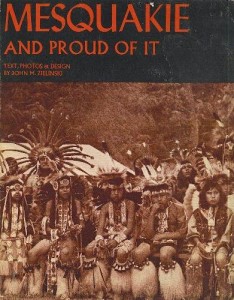
The Meskwaki are proud that they got some of their territory back not through the grace of the U.S. government, but through their own peaceful efforts: they bought their old lands back from white settlers in Tama, Iowa. Thus they made Tama a settlement, and not a reservation. The billboard’s phrasing not only advertised the powwow, but it also expressed Native resistance to oppressive U.S. Indian policy with subtle humor.
This year’s Meskwaki powwow will be held in Tama between August 9 and 12, 2012. For details, please see the powwow website at http://www.meskwakipowwow.com/
Are you going to attend the University of Iowa Powwow this weekend (April 7-8)? Have you ever wondered about the origins of the event? This June, Special Collections and University Archives will be presenting an exhibit on the popular history of American Indian dancing from our collections. Here is a preview that can help you understand what goes on at the powwow.
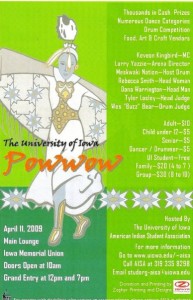
The Powwow as Cultural Revival
Even as white Americans appropriated some of their culture to define Americanness, Indians never stopped using music and dancing for their own purposes. Having moved to the big cities on the U.S. government’s post-World War Two relocation programs, many Native Americans reached back to their tribal cultures for spiritual sustenance and dignity in the face of prejudice and poverty. By the 1960s, American Indians were using the so-called “powwow circuit” – a network of dance competitions held near Native population centers across the U.S. – to socialize and revitalize their cultures.
Student lobbying for more ethnic inclusion and cultural diversity on The University of Iowa campus led to the 1971 creation of the Chicano and Indian American Cultural Center, the predecessor of today’s Latino and Native American Cultural Center. The UI’s American Indian Student Association (AISA) became a separate entity in 1990. In addition to organizing conferences, service learning projects and outreach, the Center and AISA have been greatly enriching our communities with the annual University of Iowa Powwow ever since.

The powwow is an opportunity for all to respectfully share and support Native American cultures. The event has a well-defined structure and a program. It is usually held in a large hall with the dance arena in the center, with places for the drum groups, and surrounded by sections designated for resting dancers and their relatives, and the audience. Along the inner walls of the hall are the booths of arts and crafts vendors, as well as stands that sell Native American foods such as fry bread.
There is a protocol all must follow to make the event enjoyable and respectful. The program usually opens with an invocation or prayer ceremony. The opening event is almost always the marching in of veterans of U.S. wars with the country’s colors, stepping to a song that honors their military service. The subsequent dances have a strict order, and they are announced by the master of ceremony, a position of honor in Native America. Various dances for each sex include traditional style, jingle, and fancy dancing, and they differ in footwork, regalia, posture, and meaning. Often dancers perform their own story. Their regalia are the result of years of hard work, monetary investment, and meaningful gifts. Judges evaluate the dancers in each category, but also the drum groups and singers, who come from many corners of Native America. Besides the cash prize, winning a powwow category honors the dancer or musician, and furthers their own and their family’s reputation across Native communities.
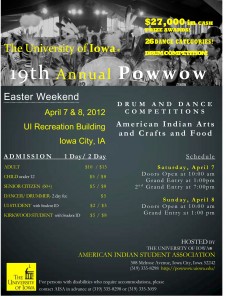
The American Indian powwow is a combination of a variety of cultural forms. Some of its most prominent dance forms like the Omaha or the Grass Dance are derived from the old warrior society dances that Karl Bodmer and George Catlin recorded in their paintings back in the 1830s. Another origin of the modern powwow are the Old Glory Blowout gatherings held by Buffalo Bill in the 1880s near Indian reservations as auditions for the rodeos, dancing and re-enactment performances of his Wild West Show. These events encouraged inter-tribal interaction and cultural exchange, and led to more frequent gatherings with participants from a variety of Native nations. Community dancing also expressed resistance to white domination when the government’s officials were suspicious of or tried to suppress dancing on reservations. Since the mid-20th century, powwows have also featured honoring dances for Native American veterans of the U.S. military – which makes them events of veterans homecoming. When you experience a powwow, you can ‘read’ the event for traces of this rich history of Native-white relations.
Please mark your calendars and visit the UI Powwow website here: http://powwow.uiowa.edu/
The American Indian Student Association welcomes donations to offset the costs of staging the powwow in our community. AISA accept checks sent to their address at
The American Indian Student Association, The University of Iowa, 308 Melrose Avenue, Iowa City, Iowa 52246 Fax: 319-335-2245 Email: studorg-aisa@uiowa.edu
Farewell to Elizabeth Catlett
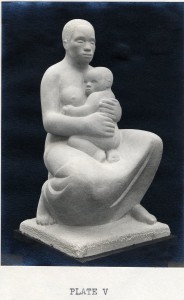 The New York Times reported today that “Elizabeth Catlett, whose abstracted sculptures of the human form reflected her deep concern with the African-American experience and the struggle for civil rights, died on Monday at her home in Cuernavaca, Mexico, where she had lived since the late 1940s. She was 96. “
The New York Times reported today that “Elizabeth Catlett, whose abstracted sculptures of the human form reflected her deep concern with the African-American experience and the struggle for civil rights, died on Monday at her home in Cuernavaca, Mexico, where she had lived since the late 1940s. She was 96. “Here’s a link to the New York Times obituary. http://www.nytimes.com/2012/04/04/arts/design/elizabeth-catlett-sculptor-with-eye-on-social-issues-dies-at-96.html
The Zine Dream and the Riot Grrrl Scene March 30th 4-6PM
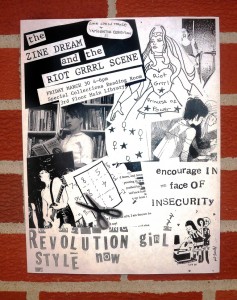 BECAUSE us girls crave records and books and fanzines that speak to US that WE feel included in and can understand in our own ways…
BECAUSE us girls crave records and books and fanzines that speak to US that WE feel included in and can understand in our own ways…
BECAUSE we must take over the means of production in order to create our own meanings.
from “Riot Grrrl Manifesto,” Bikini Kill #2
In conjunction with the Mission Creek Festival of music and literature, Special Collections hosts “The Zine Dream and the Riot Grrrl Scene” on Friday, March 30 from 4-6 pm. A cooperative project of librarians, scholars, and zine-makers, this event will highlight the 1990s Riot Grrrl movement and its independent publishing zine culture by exploring the intersection of music, writing, and social issues.
The zine open house and interactive exhibition will give visitors the opportunity to interact with and learn about zines in a variety of ways. Monica Basile, a zine-maker, artist, and PhD candidate in Gender, Women’s, and Sexuality Studies, will curate a browseable selection of zines in the reading room. We hope to open a conversation on the importance of zines and zine culture by inviting participants to share their experiences and thoughts for up to five minutes each, using the egg timer discussion format. Attendees will also have the chance to work on a collaborative zine which we will copy, collate, and share with all of the contributors. Zine newbies, Riot Grrrls, librarians, zine-makers, students, scholars, punk rockers, writers, community members – all are welcome; please join us!
We’re Moving on Up!
The thunderous noise in the halls near Special Collections & University Archives is not an approaching storm, (we have had enough water for a lifetime), but rather the sound of cart wheels rolling back and forth carrying shelves. The Books are on the Move all over the Main Library and Special Collections is no exception. Our basement storage area is infamous from the 2008 flood, when hundreds of volunteers from across the campus and the community joined in an effort to relocate 14,000 linear feet of books and manuscripts to higher floors. Now, as a consequence of the upcoming renovation work in the Main Library, we have an opportunity to honor their contribution by ensuring it will not likely be needed again. We are moving all of the collections up from the basement to the third floor. Our collections will all be housed together, greatly increasing our ability to page items quickly for our patrons.
We are undertaking this move internally so yesterday our dedicated student workers finished replacing small shelves with larger ones that will safely hold Special Collections materials and archival boxes. Our students, trained in handling rare materials and familiar with our storage locations proved themselves this summer when they shifted thousands of volumes in our third floor stacks in far less time than we planned for the project. Lindsay Morecraft has helped with both moves and she thinks student movers have advantages. “We know these materials and know that they have to be taken care of. We can see them as individual items and not as just objects to be moved so we can handle the materials better and be sure nothing gets lost, out of order, or damaged. It’s a lot of work, but in the end not going down to the basement and having everything in a central area will be a big help.”
Our heartfelt thanks go out to all of our student workers and volunteers. Though their work is hidden, today, like every day, the paging, shelving, processing, and moving are what make it possible for everyone from visiting classes, to researchers in the reading room, to junior high students working on National History Day projects, to be able to see and learn from our collections and contribute to the life of the university and our UNESCO City of Literature, Iowa City.

